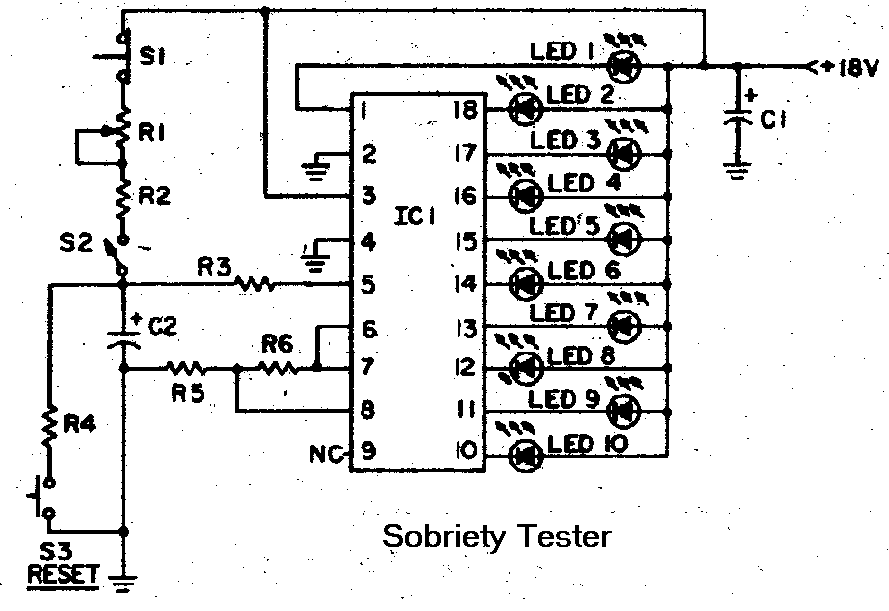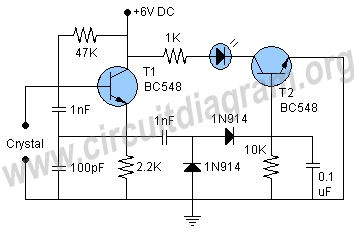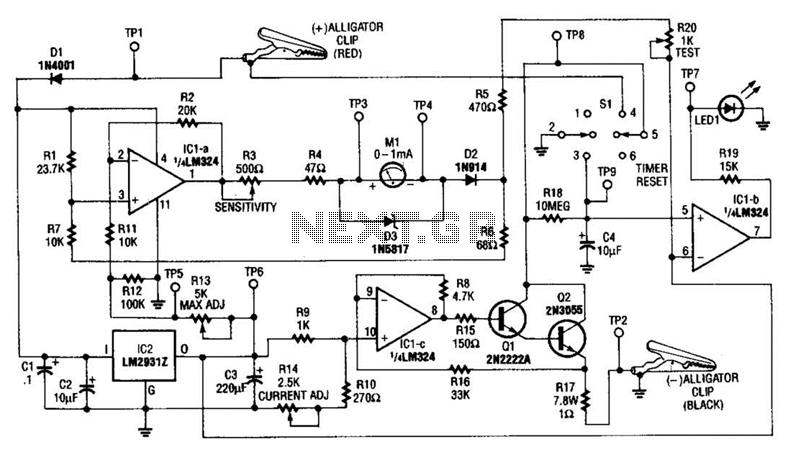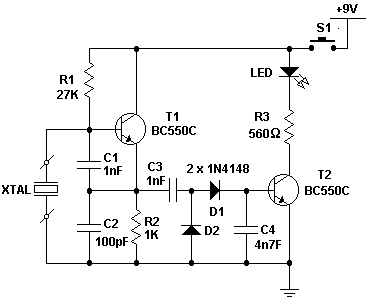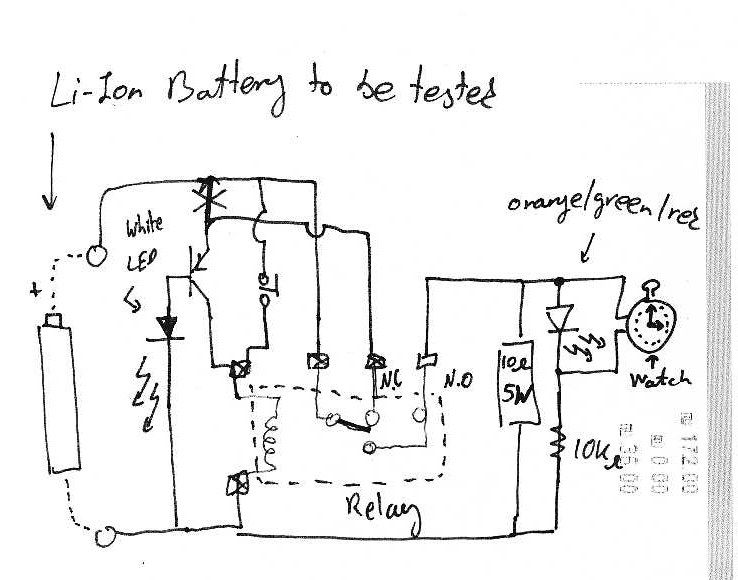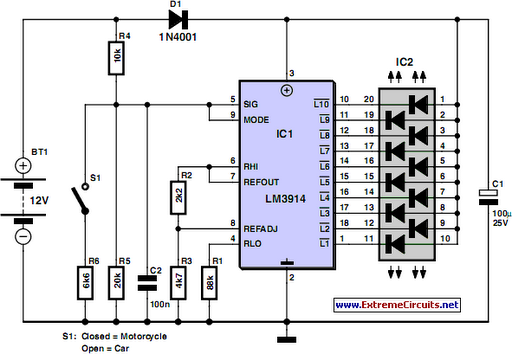
CCFL Tester for LCD Screens
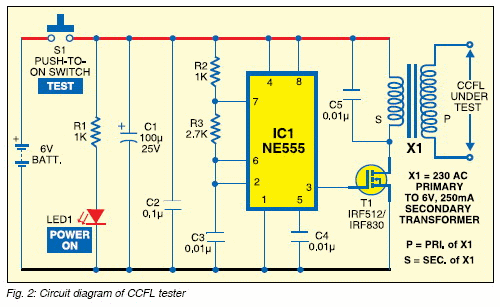
The CCFL tube is powered by a small electronic inverter circuit (CCFL inverter) that illuminates the screen electronically. This inverter circuit accepts a low-level DC input voltage and provides a high-level AC output to operate the backlight CCFL tube(s). Often, there is a need to check a faulty LCD backlight circuit to identify dead components. The absence of backlight indicates that either the CCFL inverter or the CCFL tube is non-functional. A simple circuit is available to test the CCFL tube in an LCD backlight unit, which can aid hardware technicians in expediting repair work. This basic circuit (go/no-go test) is portable, operates on a 6V battery, and can be used to test almost all types of LCD backlight CCFL tubes. The operation of the CCFL circuit is illustrated in a schematic. A timer IC (NE555, IC1) is configured as an astable multivibrator (AMV) to drive a standard MOSFET (T1, IRF 512/IRF 830). Components R2, R3, and C3 determine the operating frequency of the AMV. The MOSFET T1 switches the inverter output transformer (X1) to generate a high-voltage AC supply at its output terminals. An ordinary step-down transformer is utilized as the inverter transformer by reversing its primary and secondary windings. The circuit should be assembled on a general-purpose PCB and enclosed in a suitable cabinet. A 2-pin connector should be mounted on the front side of the cabinet to facilitate easy connection of the CCFL under test. The test switch should be positioned on the top of the frame, and the 6V battery should be housed inside the cabinet. To test a CCFL, connect its terminals to the primary leads of transformer X1 and momentarily press the test switch S1. If the CCFL is functional, a dim or bright glow will be observed (depending on the wattage rating of the CCFL being tested). It is advisable to keep the testing time as brief as possible. Caution is advised, as repairing the LCD backlight unit can be challenging even for experienced technicians; incorrect handling may lead to permanent damage to the LCD screen, necessitating a replacement.
The CCFL inverter circuit is a critical component in the operation of LCD displays, as it provides the necessary high-voltage AC power required to illuminate the CCFL tubes. The NE555 timer, configured as an astable multivibrator, creates a square wave output that drives the MOSFET. This configuration allows for efficient switching of the inverter transformer, which steps up the voltage from the low-level DC input to a high-level AC output suitable for the CCFL tubes.
The choice of components is essential for the reliable operation of the circuit. The NE555 timer is known for its stability and ease of use, while the selected MOSFET should have sufficient voltage and current ratings to handle the demands of the inverter transformer. The transformer, when configured correctly, can effectively convert the low voltage to the high voltage necessary for the CCFL operation.
When assembling the circuit, attention to detail is paramount. Proper soldering techniques should be employed to ensure solid connections, and the layout should minimize interference and optimize performance. The enclosure not only protects the circuit but also aids in user safety during testing procedures.
In summary, this circuit serves as a valuable diagnostic tool for technicians working with LCD backlight units. Its design allows for quick testing of CCFL tubes, enabling faster repairs and reducing downtime for faulty displays. Proper use and caution are advised to prevent damage to the LCD screens during testing.CCFL tube is powered by a small electronic inverter (CCFL inverter) circuit that glows the screen electronically. The inverter circuit accepts a low-level DC input voltage and provides a high-level AC output to run the backlight CCFL tube(s).
Fig. 1 shows the CCFLs for LCD. Often a need arises to check a faulty LCD backlight circuit for finding the dead components. Absence of backlight means either the CCFL inverter and/or the CCFL tube is in dead state, here is a simple circuit to test the CCFL tube in a LCD backlight unit, which might help the hardware technician to speed up the repair work. This basic circuit (go/no go test) is portable, 6V battery operated and can be used to test almost all types of LCD backlight CCFL tubes.
The working of the CCFL circuit is shown in Fig. 2. A timer IC NE555 (IC1) is wired as an astable multivibrator (AMV) to drive a standard MOSFET T1 (IRF 512/IRF 830). Components R2, R3 and C3 determine the operating frequency of the AMV. MOSFET T1 switches the inverter output transformer (X1) to produce high-voltage AC supply at its output terminals.
Here an ordinary step-down transformer is used as the inverter transformer by reversing its primary and secondary windings. Assemble the circuit on a generalpurpose PCB and enclose in a suitable cabinet. Fix the 2-pin connector on front side of the cabinet in such a way that the CCFL under test can easily be connected here.
Fix the test switch on top of the frame. Keep the 6V battery in side the cabinet. To test a CCFL, connect its terminals to the primary leads of transformer X1 and press test switch S1 momentarily. If the CCFL is good, you will notice a dim/bright glow in it (depends on the wattage rating of the CCFL under test).
Always try to keep the test time as short as possible. Warning. Repairing the LCD backlight unit is not an easy task even for experienced technicians. If you do something wrong you may permanently damage the LCD screen and have to buy a new one! Be the first of your friends to get free diy electronics projects, circuits diagrams, hacks, mods, gadgets & gizmo automatically each time we publish. Your email address & privacy are safe with us ! 🔗 External reference
The CCFL inverter circuit is a critical component in the operation of LCD displays, as it provides the necessary high-voltage AC power required to illuminate the CCFL tubes. The NE555 timer, configured as an astable multivibrator, creates a square wave output that drives the MOSFET. This configuration allows for efficient switching of the inverter transformer, which steps up the voltage from the low-level DC input to a high-level AC output suitable for the CCFL tubes.
The choice of components is essential for the reliable operation of the circuit. The NE555 timer is known for its stability and ease of use, while the selected MOSFET should have sufficient voltage and current ratings to handle the demands of the inverter transformer. The transformer, when configured correctly, can effectively convert the low voltage to the high voltage necessary for the CCFL operation.
When assembling the circuit, attention to detail is paramount. Proper soldering techniques should be employed to ensure solid connections, and the layout should minimize interference and optimize performance. The enclosure not only protects the circuit but also aids in user safety during testing procedures.
In summary, this circuit serves as a valuable diagnostic tool for technicians working with LCD backlight units. Its design allows for quick testing of CCFL tubes, enabling faster repairs and reducing downtime for faulty displays. Proper use and caution are advised to prevent damage to the LCD screens during testing.CCFL tube is powered by a small electronic inverter (CCFL inverter) circuit that glows the screen electronically. The inverter circuit accepts a low-level DC input voltage and provides a high-level AC output to run the backlight CCFL tube(s).
Fig. 1 shows the CCFLs for LCD. Often a need arises to check a faulty LCD backlight circuit for finding the dead components. Absence of backlight means either the CCFL inverter and/or the CCFL tube is in dead state, here is a simple circuit to test the CCFL tube in a LCD backlight unit, which might help the hardware technician to speed up the repair work. This basic circuit (go/no go test) is portable, 6V battery operated and can be used to test almost all types of LCD backlight CCFL tubes.
The working of the CCFL circuit is shown in Fig. 2. A timer IC NE555 (IC1) is wired as an astable multivibrator (AMV) to drive a standard MOSFET T1 (IRF 512/IRF 830). Components R2, R3 and C3 determine the operating frequency of the AMV. MOSFET T1 switches the inverter output transformer (X1) to produce high-voltage AC supply at its output terminals.
Here an ordinary step-down transformer is used as the inverter transformer by reversing its primary and secondary windings. Assemble the circuit on a generalpurpose PCB and enclose in a suitable cabinet. Fix the 2-pin connector on front side of the cabinet in such a way that the CCFL under test can easily be connected here.
Fix the test switch on top of the frame. Keep the 6V battery in side the cabinet. To test a CCFL, connect its terminals to the primary leads of transformer X1 and press test switch S1 momentarily. If the CCFL is good, you will notice a dim/bright glow in it (depends on the wattage rating of the CCFL under test).
Always try to keep the test time as short as possible. Warning. Repairing the LCD backlight unit is not an easy task even for experienced technicians. If you do something wrong you may permanently damage the LCD screen and have to buy a new one! Be the first of your friends to get free diy electronics projects, circuits diagrams, hacks, mods, gadgets & gizmo automatically each time we publish. Your email address & privacy are safe with us ! 🔗 External reference
